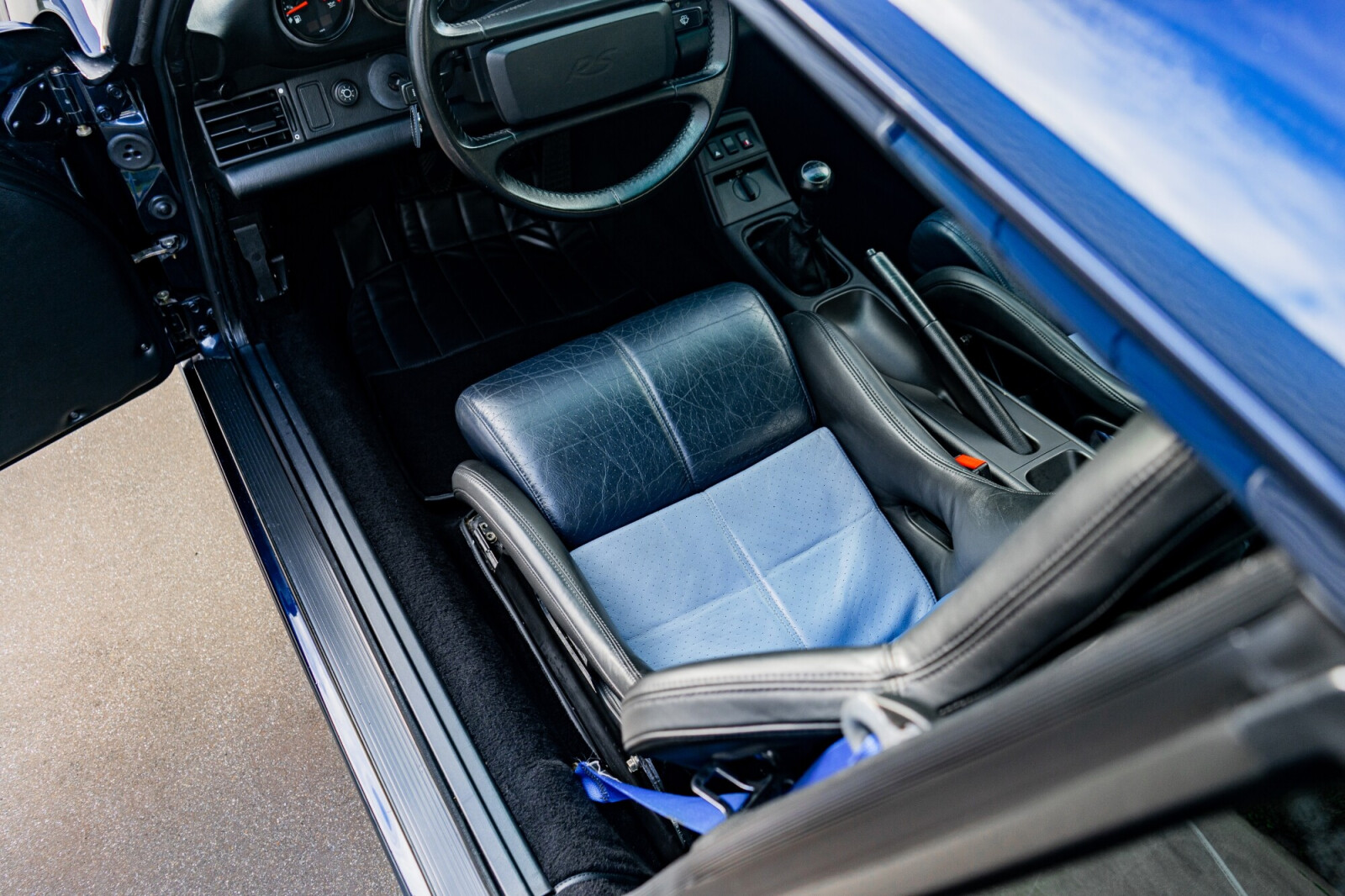Porsche 964 RS
- Chassis: WP0ZZZ96ZNS4906**
- Motor: 3.600cc
- Transmissie: Manueel
- Kilometerstand: 111330 km
- Kleur: Midnight Blue Metallic (L37W) / Black / Darkblue / Maritimblue / Lightblue interior (NS)
- Nieuw geleverd in Duitsland
- Eén van de 2,276 964 RS's
- Klassiek en zeldaam Midnight Blue Metallic
- 964RS magnesium velgen
- Uitgebreide onderhoudshistoriek
'What the RS has done is take the technical brilliance of the latest Carreras and put back the missing excitement of some earlier, less pampering generations.' – Brian Laban, Performance Car magazine.
Deze 964 RS
De auto werd op 23 juni 1992 nieuw geleverd in Duitsland aan zijn eerste eigenaar. Er is weinig bekend over zijn eerste levensjaren, maar na slechts 6 jaar kwam de auto aan in België. Sindsdien heeft de auto in 25 jaar tijd vier Belgische eigenaars gehad; elk onderhield de auto zoals het hoort, inclusief een volledige schildering in 2012. De laatste eigenaar kocht de auto in 2016; hij besloot onlangs de auto te verkopen omdat hij er slechts 2.000 km mee had gereden.
Vandaag wordt de 964 gepresenteerd in uitstekende 'showroom' staat, met momenteel een totaal van slechts 111.330 kilometer op de teller. Dit exemplaar is uitgevoerd in Midnight Blue Metallic met een blauw interieur. De uitgebreide onderhoudshistorie is vastgelegd in verscheidene facturen, oude inschrijvingsbewijzen, keuringen en meer. De auto wordt ook geleverd met het originele handleiding en de kaart met sleutelcode. De magnesium 17″ Cup wielen zijn uitgerust met N-gecodeerde Michelin Pilot Sport banden gedateerd 2020-'21.
Deze Carrera RS is van binnen en buiten prachtig gepresenteerd en wordt geleverd met de originele magnesium velgen, toolkit, reservewiel en een gevarendriehoek.
Deze prachtige 964 is onaangetast en toch gebruikt zoals het met een echte RS bedoeld is. Hij is afgewerkt in de buitengewone kleur Midnight Blue Metallic en is op zoek naar een gepassioneerde nieuwe eigenaar.
EIGENAARS
- 1992 : Germany
- 1998 : Mr. L.C. - Belgium
- 2011 : Mr. J.A.
- 2014 : Mr. F.L
- 2016 : Mr. B.D.L
- 2023 : RSC
HISTORIEK
- 1998 : 59.300km
- 2000 : 77.047km
- 2001 : 81.437km
- 2002 : 87.900km
- 2003 : 91.350km
- 2004 : 92.528km
- 2005 : 94.311km
- 2006 : 96.460km
- 2007 : 98.333km
- 2008 : 99.637km
- 2009 : 100.705km
- 2010 : 103.293km
- 2011 : 103.500km
- 2012 : 105.888km
- 2013 : 107.500km
- 2014 : 108.890km
- 2015 : 109.385km
- 2016 : 109.680km
- 2017 : 109.785km
- Today : 111.330km
CAR-PASS : https://public.car-pass.be/vhr...
More insight on the 964RS
Evoking memories of the legendary 2.7 and 3.0-litre RS and RSR 'homologation specials' of the 1970s, in 1991 Porsche introduced the Type 964 Carrera RS. A lightweight variant like its illustrious forebears, the beautiful newcomer was based on the 'Carrera Cup' competition car and sold in Europe only.
The Carrera RS retained the 3.6-litre engine, albeit boosted in maximum output to 260bhp and equipped with a lightened flywheel for improved response. The G50/10 five-speed transmission featured closer ratios, an asymmetrical limited-slip differential, and steel synchromesh, while the suspension was lowered and stiffened. The 0-100km/h time dropped to 5.4 seconds and the Carrera RS had a top speed of 260km/h.
The interior was stripped out completely and the power steering, power windows and seats, rear seats, air conditioning, cruise control, sound deadening material, and stereo system removed. Two lightweight racing bucket seats were fitted instead. The front bonnet was made of aluminium and the chassis was seam welded, while the side windows were made from thinner and lighter glass. Rounding off this radical exercise in weight reduction, the Carrera RS was equipped with 17" Cup magnesium wheels. The result was a total weight saving of around 150kg compared to the Carrera 2, transforming the RS into a faster, more agile, and more responsive car.
Brian Laban found that any feeling of remoteness or soft touch had gone completely, and reckoned that the controls never felt more solid or precise. In his opinion the Porsche could not be faulted, the verdict being that the Carrera RS was 'exactly what a performance car should be'.
- Merk
- Porsche
- Model
- 964 RS
- Chassisnummer
- WP0ZZZ96ZNS4906**
- Eerste inschrijving
- 23/06/1992
- Kilometerstand
- 111330 km
- Vermogen
- 260 hp
- Brandstoftype
- Benzine
- Transmissie
- Manueel
- Kleur
- Midnight Blue Metallic (L37W)
- Interieur
- Black / Darkblue / Maritimblue / Lightblue interior (NS)

























































